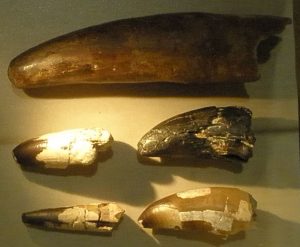
Credit: Ghedoghedo/Wikipedia
In the dinosaur-rich fossil beds of Morocco, dated to about 100 million years ago, scientists have discovered a strange new crocodile. A fossil was found of an upper and lower jaw preserved together, with oddly shaped teeth. At first, researchers thought it was the snout of a small mammal, but later determined that it belonged to a member of the crocodile-line of evolution. Hardly a monster, this little crocodile-relative would have been less than 2 feet (60 cm) in length.
The new Moroccan fossil sported complex teeth with cusps and basins for crunching through the exoskeletons of insects, much like a small mammal would. Modern crocodiles have relatively simple conical teeth and cannot chew their food, instead swallowing their prey whole or in large chunks. The new crocodile-relative had far more specialized teeth.
In order to study the specimen, the research team of Dr. Jeremy Martin (Centre National de la Recherche Scientifique researcher at Laboratoire de Géologie de Lyon) and Dr. France de Lapparent de Broin (Muséum National d’Histoire Naturelle, Paris) looked at high-resolution CT scans to study the bones’ internal structure without having to destroy any of the fossil. The team also looked at the teeth under very high magnification in order to see the wear pattern and figure out how this odd ‘crocodile’ was using its teeth.
The researchers named the new animal Lavocatchampsa sigogneaurussellae after the French paleontologist René Lavocat (1909-2007) who worked extensively on African fossils, as well as Dr. Denise Sigogneau-Russell and husband Dr. Donald Russell who acquired the fossil. Dr. de Lapparent de Broin says “In the early 1990s, Cretaceous mammals were intensively searched for in Africa; until full preparation eventually revealed single-rooted teeth, it was hard to conceive that the specimen could belong to a crocodile”.
Regarding the new find, lead author Dr. Martin says “The Kem Kem Beds in Morocco have yielded a wealth of extinct creatures, mostly large animals, but with this discovery we realize that part of the ecosystem remains untapped, especially when it comes to small-bodied terrestrial vertebrates”.
Given this animal would have lived alongside giant carnivorous dinosaurs, life could not have been easy for the tiny ‘crocodile’. Not only that, but the waters were teeming with other species of much larger and highly carnivorous crocodile-relatives. Other researchers have suggested close relatives of Lavocatchampsa likely lived on land. Perhaps at the time, it was safer under the feet of dinosaurs than in the water with its larger cousins. Dr. Martins adds “The next step will be to understand their place in this peculiar ecosystem and understand how the ecosystem as a whole was functioning and evolving. Such a discovery opens fascinating perspectives for paleoecological research”.
Reference:
Martin, J. E., and F. de Lapparent de Broin. 2016. A miniature notosuchian with multicuspid teeth from the Cretaceous of Morocco. Journal of Vertebrate Paleontology. DOI: 10.1080/02724634.2016.1211534.
Note: The above post is reprinted from materials provided by Society of Vertebrate Paleontology.










